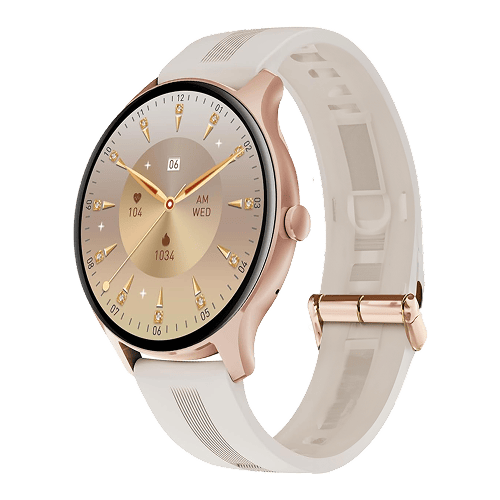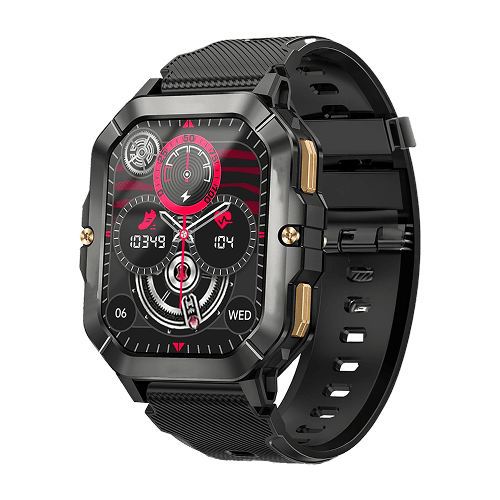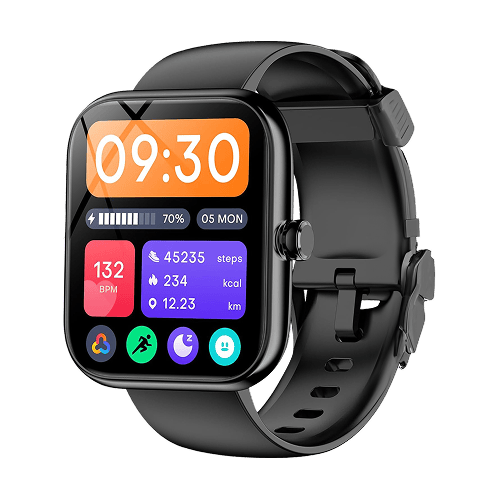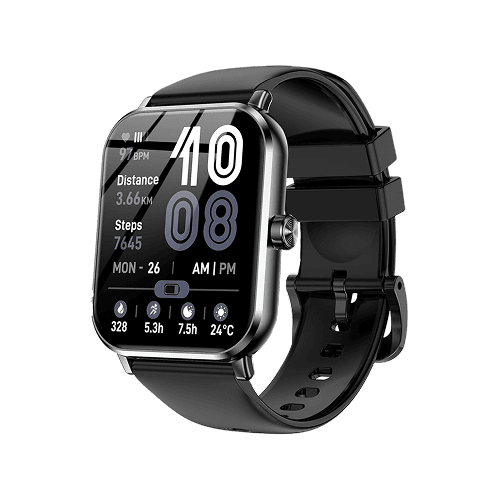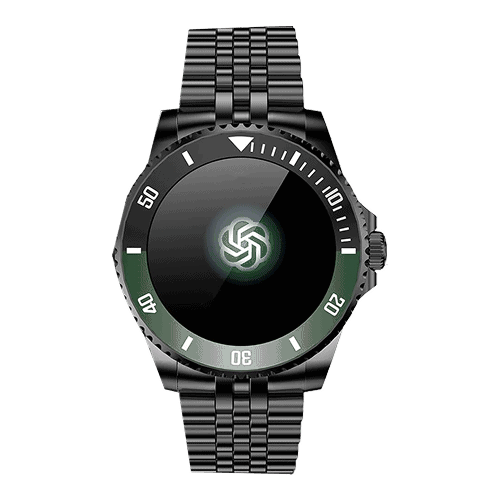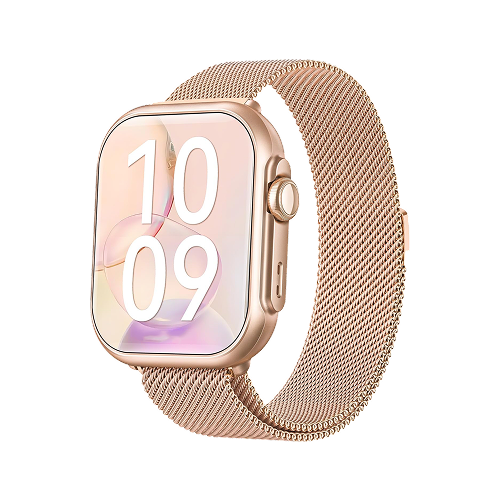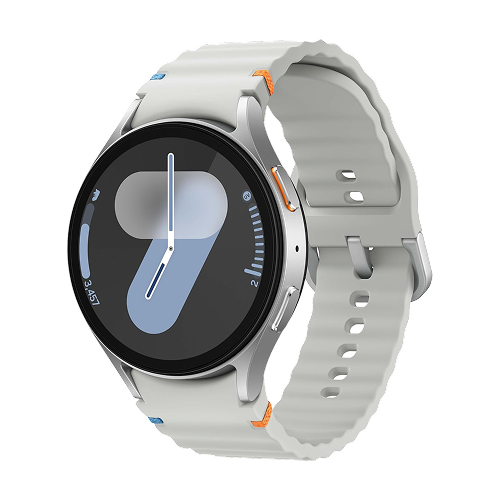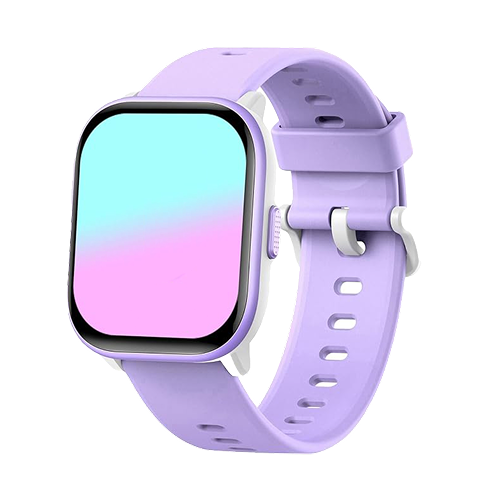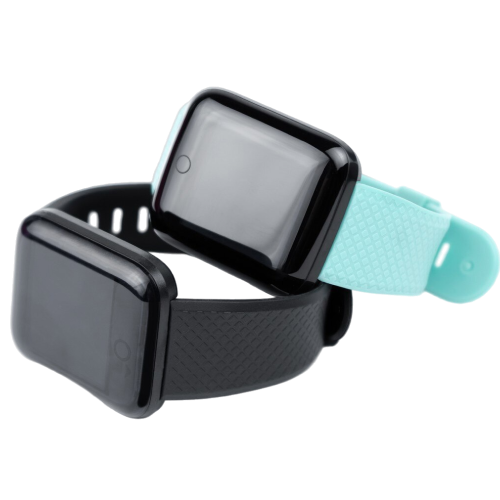If you’ve held back from buying a smartwatch until now, it’s not too late to get in the game. In fact, there’s never been a better time, with countless models available—each offering its own mix of features to help you stay connected and simplify daily life.
Smartwatches started out mainly as health and fitness trackers but have grown into something much more versatile. They’re everywhere now and have essentially become extensions of our phones. Nearly anything you can do on a smartphone, you can now do from your wrist.
Choosing one can feel overwhelming, especially if you’re unsure where to start or how they actually work. But don’t worry—we’ll cover the essentials and take a closer look at what matters most. By the end, you’ll have the insight you need to find the right smartwatch for you.
The Most Important Features of a Smart
There are crucial features and specs that determine the true quality of a smartwatch. For the time being, we’ll put aside personal preferences to some degree, but many of these also require you to identify what’s most important to you.
Fitness and health tracking
The number one reason most people get a smartwatch is to stay on top of their health and fitness goals. There are ways to track fitness with your smartphone, but it’s not nearly as practical as wearing a smartwatch.
That said, not all smartwatches offer the same fitness and health tracking features. Here’s a quick breakdown of the most common types of tracking you’ll get with most smartwatches:
- Activity-only: These smartwatches offer tracking for basic fitness metrics such as steps, calories, and distance. They’re lightweight, affordable, and excellent for athletes.
- Activity + Basic: This is the best option for those who want the best of both worlds at an affordable price. They often offer basic health tracking, such as heart rate monitoring and sleep tracking, in addition to fitness metrics.
- Full Fitness + Health: Those seeking comprehensive fitness and health tracking will be impressed with these smartwatches as they often provide readings for heart rate, sleep, blood oxygen, stress, and workout detection.
- Advanced: These high-end smartwatches offer a full array of health and fitness tracking, including ECG, irregular heart rhythm alerts, blood oxygen, and blood pressure monitoring. They’re better suited for health-conscious individuals rather than fitness enthusiasts.
It’s important to note that not all smartwatches will offer the same readings, as sensor accuracy varies between models. Also, smartwatch readings should never be used as a true indicator of health. They can provide an idea or baseline of general health, but if you have any health-related concerns, it’s always best to consult your physician.
For reference, here is an idea of the most popular sensors consumers look for in a smartwatch and a summary of what they do:
Battery life
The biggest hassle with wearable devices is keeping them charged. But if you choose a smartwatch with strong battery performance, you won’t have to worry about plugging it in every night.
Most smartwatches last between three and seven days on a single charge, depending on usage and display type. Models with OLED or AMOLED screens are more power-efficient than those with always-on LCDs. Some premium or hybrid models can stretch battery life to several weeks by limiting advanced features like GPS, Wi-Fi, or continuous heart-rate monitoring.
Battery capacity is usually measured in milliamp-hours (mAh), but that number alone doesn’t tell the full story. A 400 mAh battery in one smartwatch might last longer than the same size battery in another because of software optimization or the efficiency of the processor. Brands like Garmin and Amazfit are known for power-efficient designs, while models from Apple and Samsung often trade battery longevity for brighter screens and higher performance.
You can get a quick idea of expected battery life by checking the manufacturer’s claimed duration and comparing it to real-world tests from reviewers. If you often use features like GPS tracking, LTE connectivity, or sleep monitoring, look for models rated for multi-day performance under heavy use.
Even when a smartwatch runs low, recharging usually isn’t a long wait. Most can go from empty to full in about 1.5–2 hours. Some newer models support fast or magnetic charging that brings the battery from 0 to 80% in around 45 minutes. If convenience matters, also consider models that support wireless charging or use a standard USB-C cable instead of a proprietary dock.
Water-resistance
You’d be hard-pressed to find a smartwatch that isn’t water-resistant to some degree these days. Most smartwatches feature a durable, water-resistant exterior that prevents moisture from entering.
Water-resistance is a crucial consideration for swimmers or winter sports enthusiasts, but it’s also essential for inclement weather, such as when it’s raining or snowing.
A device’s water-resistance and dust protection are indicated by its Ingress Protection (IP) rating. You’ll typically see smartwatches with either an IP67 or IP68 rating, but here’s a quick breakdown of the most common IP ratings for smartwatches just in case you encounter something different while shopping.
Platform support
One of the most common mistakes people make is buying a smartwatch that isn’t compatible with their phone. Smartwatches aren’t fully standalone devices—most need to sync with a smartphone to unlock their full functionality, such as GPS navigation, health and fitness tracking, and phone calls.
There are two main operating systems in the smartphone world: iOS, used exclusively by Apple’s iPhone, and Android, which powers most other brands.
Apple Watches only work with iPhones, so Android users should avoid them. Conversely, the latest Samsung Galaxy Watch models are designed to work exclusively with Android.
Aside from those two, most smartwatches today support both iOS and Android. However, certain features may work better on one platform than the other, depending on the model and its companion app.
GPS & Cellular
Beyond health tracking, smartwatches help you stay connected even when your phone isn’t in your hand. However, how independent they are depends on the type of model you choose.
GPS-only smartwatches act as extensions of your smartphone. They rely on a Bluetooth connection, meaning your phone needs to stay within range for features like calls, messages, and GPS navigation to work. These models are typically more affordable and ideal for everyday wear.
Cellular smartwatches, by contrast, include built-in 4G or 5G/LTE connectivity, allowing you to make calls, send messages, and use GPS without your phone nearby. They’re especially useful for outdoor activities or for anyone who prefers to travel light.
Keep in mind that cellular smartwatches require a separate wireless plan to operate independently, which adds to the overall cost.
Smart Features
The neat thing about most smartwatches is the smart features they’re loaded with. The most basic smartwatches, at the very minimum, will show you notifications from your phone, including texts and app alerts. These models are pretty barebones, so you won’t be able to interact with those notifications, but at least you’re connected.
Mid-tier models allow you to make and receive phone calls, send and receive text messages, making them excellent if you want to put your phone aside for a while. Premium smartwatches offer full integration with compatible apps you have on your smartphone.
Here is a list of the most essential smart features and apps to look for:
- Social Media
- Music Streaming
- Calendar
- Phone & Text
- Voice Assistant
- Contactless Payment
- Quick Reply
- Third-Party Apps
Features Based on Preference
Although there are objective differences across all smartwatches, the right one for you depends primarily on your preferences. Above all else, you should like the look of your watch and find it easy to use.
User Interface
Like smartphones, not all smartwatches have the same operating system. And again, like smartphones, there are pros and cons to both. A lot of it comes down to preference and which type of smartphone you have, but some tend to be more fluid and offer a better user experience.
Here’s a summary of the most common smartwatch operating systems, along with a breakdown of the good and bad of each one:
Case Design & Style
Smartwatches come in various shapes, sizes, and builds. It’s purely a matter of preference, but naturally, you want a smartwatch that you find appealing, not just functional. You can opt for a round or more square case based on what you find more practical and aesthetically pleasing, but there are four primary categories for smartwatch styles:
- Classic: These smartwatches are round and resemble traditional analog watches.
- Sport: They’re rugged yet lightweight with a durable case that’s ideal for outdoor adventures.
- Minimal: Typically squared or round, with a smaller case. Best for everyday wear.
- Luxury: These watches stand out more thanks to their thicker case and premium materials.
Material is another worthwhile consideration. You want a durable smartwatch that is both scratch-resistant and lightweight, yet still comfortable. Cases are typically made from one or a combination of the following materials:
- Titanium: This is arguably the best material for a smartwatch as it’s lighter than stainless steel yet still highly scratch-resistant and durable.
- Aluminum: It’s a solid material that’s used for basic and mid-tier models. It’s the most lightweight material, but it’s more prone to scratches than titanium.
- Stainless Steel: This material gives a smartwatch a more premium feel, but it also makes the device feel bulkier than those with aluminum or titanium cases. Finishes often look shiny, making this material best suited for luxury smartwatches.
- Plastic: the cheapest material, often used for kids and budget-friendly models. Plastic cases look and feel less premium, but they’re excellent for athletes.
Display Size
Display size is entirely up to you. My recommendation? It’s best to get a display size that makes it easy for you to navigate menus and read information. However, you should also consider your wrist size. The last thing you want is a watch that feels too small or big.
These are the most common ranges for display size:
- Small: If you have a small wrist or just prefer a more lightweight smartwatch, go with a model that has a screen no larger than 1.2” or 1.3”.
- Medium: The best choice for most users, falling within a range of 1.4”-1.5”.
- Large: Want something more durable, or don’t mind a bulkier watch? You can get one with a display size of 1.6”, 1.7”, or even bigger.
Accessibility
Accessibility features make smartwatches easier to use for people with various disabilities or mobility limitations. These tools help ensure that everyone can benefit from the device’s core functions—whether it’s communication, safety, or fitness tracking.
Common accessibility options include text-to-speech and voice control, which let users navigate menus, read notifications, or send messages without relying on the touchscreen. Haptic alerts provide gentle vibrations for notifications, alarms, or navigation cues, making them especially useful for users with hearing impairments.
Many models now also include fall detection and Emergency SOS, which automatically call a designated contact or emergency services if a fall is detected or if the user triggers an alert manually. This can be invaluable for older adults or anyone with health conditions that increase their risk of falling.
Some brands go further by offering high-contrast modes, larger text options, screen readers, or customizable gestures that allow for one-handed or touch-free operation. For example, Apple’s AssistiveTouch and Samsung’s Universal Gestures features enable users to control the watch through hand movements instead of taps or swipes.
Display
Display quality matters less on a smartwatch than on larger screens like TVs or tablets since the pixel density is already high enough that individual pixels aren’t visible. Still, if you’re curious about resolution or pixels per inch (PPI), you can find those details in the user manual or on the manufacturer’s website.
Size and Dimensions
Case width and screen size are more relevant than exact measurements, as they affect how the watch fits on your wrist and how comfortable it feels during wear. If you want precise dimensions, they’re usually listed on the box, in the manual, or online under the product specifications.
Connectivity
Most modern smartwatches include Bluetooth and Wi-Fi, which is all you need for smooth syncing and app updates. There are different versions of these technologies, but the variations have little impact on everyday performance. Many models also include GPS or even cellular connectivity for added convenience. If you’d like to see the exact specifications, they’re always available in the product details.
Most Popular Smartwatch Brands
Now we’re getting to the fun stuff, and by now you might be curious about what the top smartwatch brands are. We’ll give you a list of the best brands to consider, as well as the pros and cons of each brand. That way, you can choose the smartwatch that best aligns with your preferences, fitness goals, and smartphone.
Most Popular Types of Smartwatches
Although all smartwatches have the same goals, which include health tracking and phone functionality, some are specifically designed for a purpose. With that in mind, we can categorize any smartwatch to distinguish what sets it apart from others.
Lifestyle
These are your standard smartwatches that don’t do any specific thing exceptionally well, but excel in all areas. They generally have an unassuming design, making them best for everyday wear or for light activities. In terms of functionality, they typically offer reliable health and fitness tracking, app integration, and other valuable features, such as contactless payment and voice assistants.
If you want something lightweight, relatively affordable and reliable to wear on an everyday basis, these are the best smartwatches to consider:
- Apple Watch Series 10
- Samsung Galaxy Watch 8
- Google Pixel Watch 3
- Apple Watch SE
Fitness
If you’re an athlete or someone who’s really into fitness, then you’ll need a smartwatch that prioritizes exercising, health, and recovery. Fitness smartwatches can be lightweight or robust, depending on your preference, and the sensors should provide accurate readings. The battery life isn’t usually very long for smartwatches compared to other models, but the rugged build makes them suitable for most indoor and outdoor activities.
Need a smartwatch to help you achieve your fitness goals or stay on top of your health? Check these out before anything else:
- Amazfit Active 2
- Garmin Fenix 7S Pro
- Fitbit Sense 2
- Garmin Vivoactive 6
Hybrid
One reason some people avoid getting a smartwatch is that they don’t like how most models have that “techy” look. Some find it clunky and less aesthetically appealing than a traditional watch. That’s where hybrid smartwatches come in.
Hybrid smartwatches look like regular wristwatches because of the analog face, but they have sensors for tracking health and basic fitness metrics. They’re terrific for casual everyday wear, and even for special occasions. Plus, you can keep track of metrics such as steps, calories and pace to stay on top of your fitness.
Want the best of both worlds? Here are a few elegant hybrid smartwatches with some neat innovative features:
- Withings ScanWatch Horizon
- Garmin Vivomove Trend
- Withings ScanWatch Nova
Outdoor
Being outdoors means you’re exposed to the elements as well as unexpected hazards. That can be true whether you’re on a hiking trail or snowboarding, so you’ll need a smartwatch that’s rugged enough to withstand all that.
Outdoor smartwatches are highly durable, but they offer a wide array of features to help you stay connected. Accurate GPS is a must-have for any outdoor smartwatch, as many users rely on it to track outdoor workouts, such as jogging and hiking, or to keep track of their location while in the wilderness.
Before you head out the door on your next adventure, consider sporting one of these on your wrist:
- Apple Watch Ultra 2
- Garmin Fenix 8
- Garmin Forerunner 965
- Garmin Instinct 3 Solar
Golf
Gold smartwatches are very similar to outdoor smartwatches, but their primary focus is on features designed to help you play your best round of golf. In addition to standard smartwatch features such as health tracking, GPS, and phone calls, you’ll often have access to a handful of neat golf-focused features.
The best golf smartwatches are loaded with over 40,000 courses and provide distances to the front, middle, and back of greens, as well as hazards. They also offer shot tracking, virtual caddie, PlaysLike distance, and other features to help you gain an edge on the course.
If you want to bring down your handicap, you might want to consider one of these smartwatches before your next round:
- Garmin Approach S70
- Garmin MARQ 2 Golfer
Luxury
Smartwatches aren’t exactly known for their “elegant” look. They’re designed to be more practical than anything else, but that doesn’t mean there aren’t luxury smartwatches that can give you a fashion boost.
If you want something that resembles a traditional wristwatch but looks more premium than a hybrid watch, a luxury smartwatch is what you want. These watches are crafted from durable materials, resulting in a shiny appearance and a premium feel. They’re not the best for health tracking, but if you want basic smart features and a watch that catches the eye of those around you, it’s definitely your best bet.
Whether you want to complement your suit or stand out in a crowd, one of these luxury smartwatches can put the finishing touch on your outfit:
- TAG Heuer Connected Calibre E4
- Garmin MARQ
- VERTU Grand Smartwatch
For Kids
It’s not realistic to be close to your child at all times, but you can stay connected with them if they’re wearing a smartwatch. There are many models geared toward children. They typically feature a simple design, a user-friendly interface, parental controls, and a range of apps designed for kids to learn, play, and have fun.
Kids’ smartwatches are super affordable and offer basic tracking, but they’re nowhere near as versatile as other types of smartwatches. Still, they’re perfectly fine for kids aged 8-14. Plus, many can be used without a smartphone.
Kids can stay connected with these smartwatches:
- Verizon Gizmo Watch 3
- TickTalk 5
- Gabb Watch 3e
How to Connect A Smartwatch to Your Phone
Even if you’re not the most tech-savvy person in the world, it’s not too difficult to sync a smartwatch with your phone. Although different brands and models have unique ways of setting up a smartwatch, the overall process is essentially the same and goes something like this:
- Charge smartwatch to 100%
- Download the corresponding app
- Turn on Bluetooth on your phone
- Find the smartwatch under the list of Bluetooth devices and connect
- Follow on-screen instructions to complete first-time setup.
It may sound a bit complicated if you’ve never done it before, but when in doubt, consult the manual that came with your smartwatch. It’ll tell you everything you need to know and guide you through a step-by-step process to set it up.
How Much Does A Smartwatch Cost?
As you may have correctly guessed, a smartwatch’s price depends on many factors, including brand, specs, and features. As a rule of thumb, the more features a smartwatch offers, the more expensive it is. However, other factors can influence price, such as the display, build quality, operating system, and health tracking features.
It’s not as clear-cut as it sounds, but here’s a general guide for smartwatch prices:
- $50-$300: These are typically basic smartwatches with minimal tracking features and phone functionality. They’re usually best for kids, everyday wear, or tracking health metrics during light activity.
- $300-$700: Mid-tier options usually fall in this range. These smartwatches typically offer a range of health and tracking features, as well as additional premium features such as voice assistants, fall detection, and contactless payment. These are ideal for individuals with an active lifestyle or those seeking a reliable smartwatch for everyday use.
- $700-$1,000+: Luxury, hybrid and advanced medical-grade smartwatches that offer accurate tracking, and premium smartwatches fall in the $700-$1,000 range. But you can expect to spend well over $1,000 for a smartwatch with a luxury design and look.


